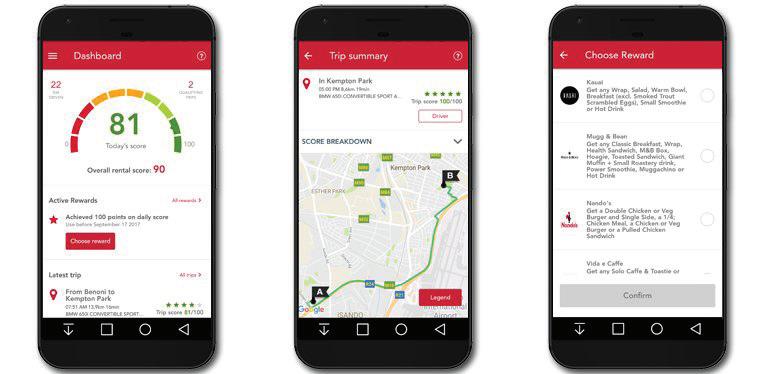
8 minute read
Real value
What’s the real value of joining a loyalty programme?


BETH AMATO sizes up fi ve different schemes to understand how they benefi t their respective members

With the global social and economic upheavals brought about by the COVID-19 pandemic, brands need to retain and attract returning customers, but is a loyalty and rewards programme based on simple perks enough? Do cash-conscious South Africans rely on brands to woo them with innovative incentives that stand out from the rest in terms of added value? Do customers prefer gami ed reward systems or being linked to a charitable mission?
According to the Truth & BrandMapp Loyalty Landscape Whitepaper 2019/2020, “cashback” is the most-enjoyed bene t, with 63 per cent of respondents indicating this. Discount vouchers rank second, with 45 per cent of respondents stating that vouchers are their most enjoyed loyalty bene t. Essentially, monetary-related bene ts are usually more appealing to consumers, particularly in South Africa.
While monetary-related loyalty programmes are the most popular with South Africans, it doesn’t really matter what shape or form the programmes come in, says Kerry Thomas, the head of customer experience at IQbusiness. “South Africans simply love a good loyalty programme. Around 72 per cent of economically active people use them; they’re seen as ways to save money and this is especially useful in these times.” Loyalty and reward programmes incentivise repeat business and can be a tool to drive a change in a customer’s purchasing behaviour, adds Thomas. This is because they build trust, customer satisfaction, and perceived value – the three factors required
Kerry to create loyal customers. Thomas In what ways are South African loyalty and rewards programmes aiming to ensure long-term customer retention?
Lynette Saltzman

Dis-Chem Spend and redeem at multiple partner locations, and give back
There are 5.7 million Dis-Chem Loyalty Benefi t members in South Africa, and the programme is both a money-reward programme as well as mission-driven. A shopper earns loyalty points on purchases (including those at partner stores if they are registered on this partner’s loyalty programme) and can redeem these points at the till against the total bill at checkout.
Points are earned in real time, meaning that the customer can pay with their points there and then, and the points don’t expire either. “The programme has a strong social responsibility component, with a portion of eligible purchases being donated to the Dis-Chem Foundation,” says Dis-Chem co-founder Lynette Saltzman.
The spirit of giving back to alleviate poverty and inequality means that customers connect more deeply with a brand, and trust it to build a better future. Dis-Chem, for example, runs community clinics, wellness buses, and clean-water campaigns.
TOP 5 LOYALTY PROGRAMMES IN SOUTH AFRICA The Truth & BrandMapp Loyalty Landscape Whitepaper 2019/2020 revealed the top six loyalty and rewards programmes in South Africa this year.
1
2
3
4
5
Clicks ClubCard
Pick n Pay Smart Shopper
Dis-Chem Loyalty Benefi t
Woolworths WRewards
FNB eBucks
MTN Gamifi ed, spend-based, and a few surprises in the revamped rewards programme

As part of its #Remake2020 campaign, MTN upgraded its old rewards system (411) to YelloBucks, where for every R1 spent on bundles or a subscription, one YelloBuck is earned, which once accumulated can be spent on airtime, data bundles, social bundles, and video- and Mapula music-streaming services, or saved and redeemed for Bodibe retail products.
When customers download the MTN app, they are automatically awarded 200 YelloBucks and one for every day they’re active on the network. Moreover, prizes are won when YelloBucks are redeemed: customers can access the play store and redeem anything contained in the rewards redemption catalogue. “2020 has been a horrible year, with many people losing so much,” explains MTN SA chief consumer offi cer Mapula Bodibe. “Very little was as it should have been. In an effort to lift spirits as we head into summer, we’re offering South Africans a reason to end off a tough year on a high note. “Through our refreshed MyMTN rewards programme and new loyalty points currency, YelloBucks, we are unlocking incredible and much-needed value, discounts and rewards offers for our customers at a time when they need them the most. This will hopefully give them a reason to enjoy the last few months of the year, and perhaps remake celebrations they may have missed out on in the course of the year.”
Zapper Points-based and spend-based programmes work for merchants
“Having tried many implementations and iterations, we believe points-based and spend-based programmes provide provide merchants with the most meaningful results in growing their business and engendering customer loyalty, while providing Brett White consumers with real value and benefi t,” says Brett White, CEO of mobile-payments platform Zapper. White explains that the primary objective of Zapper’s loyaltybased programme is to incentivise and encourage increased repeat visits and repeat product purchases for points-based programmes, and increased basket spend for spend-based programmes. “In the period between 6 February and 6 March 2020, we saw an 8 per cent increase in basket spend. In this month, we also saw 102 584 loyalty cards assigned, and 12 687 loyalty cards completed, with 14 per cent increased spend frequency. It shows how critical it is to incentivise customers,” he adds. ›

How Zapper’s reward system works for customers How Zapper’s reward system works for customers

PPS A loyalty programme with a long-term investment view


PPS, which provides fi nancial and insurance services for graduates and professionals such as lawyers, engineers and doctors, has introduced the rewards programme Profi t-Share as a way for members who have purchased qualifying products to boost retirement savings. Quintin Augustine, executive of member value proposition at PPS, explains that the pooled money of all Profi t-Share Accounts is invested in a high-equity investment mandate, with members benefi ting from compound interest based on the performance of the markets. After the age of 55, members have the option to select the investment strategy of the PPS Profi t-Share Account. Options include to either remain in a multi-asset high-equity portfolio, move to a multi-asset medium or low-equity portfolio, or move to a fi xed-interest portfolio. This gives members the opportunity to choose how accumulated profi ts are invested, aligning with investment and retirement strategies. Funds in the Profi t-Share Account are vested and payable tax-free at retirement age.
“There are 6 804 PPS members with more than R1-million Quintin Augustinein their Profi t-Share Accounts,” says Augustine, “proving that through its mutual model, PPS gives more to its members.”
Nando’s For corporates to award employees with meal vouchers


Nando’s has supplied vouchers to companies that use them as part of employment benefi t Avis Drivesafe programmes, loyalty programmes, and call-centre agent incentives. Meanwhile, the company has partnered with Discovery Business Insurance and the Avis SafeDrive programme to award clients for good driving. “Companies and large institutions are now able to work with Nando’s to subsidise delicious Nando’s meals for their employees on their terms, wherever their workforce is currently working from,” says Jaegar Torrente, head of partner marketing and strategic partnerships at Nando’s South Africa.
“Although we offer standard vouchers, we also offer a coupon system for corporates that want to reward their employees within specifi c parameters. If, for example, they want to offer employees a subsidised meal a day from Monday to Friday on a particular Nando’s menu item, then we can create a unique coupon that caters to this specifi c request,” adds Torrente.
Torrente believes this is not a restaurant trend, but rather a corporate one. “Few restaurants are in the position we are to offer this service. We have the footprint and meal options to deliver healthy offi ce lunches no matter where a person is working. As central workspaces in a single location become less prominent, businesses are encouraging and promoting healthier lifestyle choices for their employees. It’s an exciting new era for us when the business-to-business restaurateur is on the rise, and Nando’s is readily positioned to meet this Jaegar growing need.” Torrente

Starbucks rewards

GLOBAL TRENDS
According to TripSavvy, airlines in the United States are moving from points-based to spend-based loyalty programmes, mainly to entice wealthier customers and their repeat business. Travellers who spend more, earn more – even if they pay more for fewer fl ights. These fl yers will work their way up the airline’s rewards tiers faster and unlock special perks like lounge access, early boarding or additional checked-baggage allowances.
South Africans fl ying with Emirates airlines, and who belong to the loyalty programme Emirates Skywards, will earn double points for any fl ight booked by 10 December, for travel until 31 March 2021. Moreover, Emirates Skywards has honed in on the trend of personalising loyalty and reward programmes, where qualifying members can redeem points at dining and recreation centres in 160 destinations, book taxis in over 100 cities, and earn miles when shopping across the United Arab Emirates.
Starbucks, meanwhile, has changed its transaction or points-based loyalty and rewards system to a spend-based system. This was fairer to the customers who bought the largest size latte versus the smallest size Americano. Under the new spend-based programme, customers earn two stars for every US dollar spent.
WHY LOYALTY PROGRAMMES MATTER
Forrester Research Inc recently released its market predictions for 2021. The report noted that the world will experience a harsh economic climate in 2021, which will overwhelm fl oundering marketing technology, systems and processes that have survived for too long behind a strong economy. Says the report: “The circumstances of 2020 exposed the quagmire that has been developing for marketing leaders over the last fi ve years: chief marketing offi cers need to drive customer obsession at their fi rms, rather than just guiding ad buying and promotions.”












